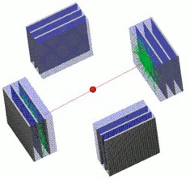A very high spatial resolution small animal PET scanner based on high granularity silicon photomultipliers
Simulation and tomographic reconstruction software for a high resolution PET scanner for small-animal imaging
A Monte Carlo simulation code will be used to evaluate a SiPM based, miniature, high-resolution camera. That will allow the estimation of the performance and the potential achievements of the proposed detector head. Moreover, the performance of the whole tomograph in terms of image spatial resolution will be studied for a point source in the center of the field of view.
The proposed camera design consists of a layer composed by a continuous slab of LSO (or LYSO) scintillator viewed by an array of compact Silicon Photomultipliers via a non-scintillating stand-off light pipe. The proposed small-animal PET system consists of two heads, each with surface dimensions of about 2.4cm x 4.8 cm. The opposing camera head separation will be as small as 10 cm to maximize sensitivity and to reduce the effect of non-colinearity of the annihilation photons. For the proposed detector head, we will read out each SiPM detector element separately, to estimate the annihilation photon position.
Geant4 based simulations will be carried out to optimize the design of a single detector head. For that purpose, single 511 keV annihilation photons are aimed at different surface points of a single detector head with different incidence angles. After tracking the 511 keV annihilation photons in the detector, only those events where an annihilation photon deposits at least 50 keV in a layer are used for further evaluation. We simulate the production of optical photons via scintillation in the crystal. The generated optical photons are then tracked until they reach the surface of the SiPM array.
Since the spatial resolution deteriorates and the displacement error (defined as the deviation of the mean of the barycenter distribution from the true hit position) increases at the edges of the detector, we'll investigate the possibility to improve the detector performance via an enhanced hit estimation method. The barycenter fails to track the true hit position near the edges of the detector. This phenomenon can be attributed to the fact that the barycenter of an event close to an edge will be pulled towards the center of the detector, since there are reduced contributions from beyond the hit position. However, we find that the skewness of the SiPM count patterns is a measure that is sensitive to the proximity of the hit to the edges of the detector. The 1D-directional skewness will be calculated for the SiPM count distribution projected onto the x or y axis, for every single event. By simulation we find that the barycenter and skewness are approximately normally distributed. The true hit position can be estimated by minimizing the log-likelihood function, which is defined as the product of the skewness and barycenter distributions.
We'll assess the image spatial resolution, by extending our simulation code to simulate a point source in the center of the scanner. In addition to a traditional FBP algorithm, the image spatial can be further enhanced using dedicated iterative reconstruction algorithms which take an appropriate model of the imaging system into account. To tackle the computational issues for this kind of reconstruction approach, a fully-3D image reconstruction method, that takes into account a parametric description of non-stationary detector blurring (DB) due to parallax and scatter in small detector arrays will be developed. Because the resulting system model leads to a computationally infeasible matrix size, a factorized system matrix approach might be used. In this approach the detector blurring is applied as 1D (or 2D in our case) blurring operation after the projection step. For the adjoint operation of backprojection the reverse order of the transposes of the projection and blurring matrices is used. In this manner the detector blurring uncertainty can be incorporated in the iterative algorithm in a computationally feasible manner.




